

Chivalry. The Code of Chivalry & The Cult of Courtly Love Admittedly, the following "rules" are a composite ideal that never existed in actual historical practice, nor can one find an exact list like this one.
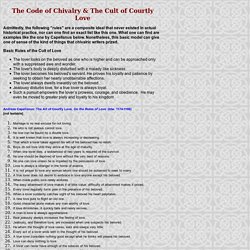
What one can find are examples like the one by Capellanus below. The Main Characteristics of Courtly Love. Courtly Love Main characteristics: 1.
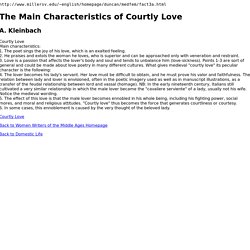
The poet sings the joy of his love, which is an exalted feeling. 2. He praises and extols the woman he loves, who is superior and can be approached only with veneration and restraint. 3. Love is a passion that affects the lover's body and soul and tends to unbalance him (love-sickness). Points 1-3 are sort of general and could be made about love poetry in many different cultures. What gives medieval "courtly love" its peculiar character is the following: 4. Courtly Love in the Middle Ages: Definition, Characteristics & Rules. Explore this lesson on courtly love, an essential concept to understanding relationships between men and women in medieval literature.
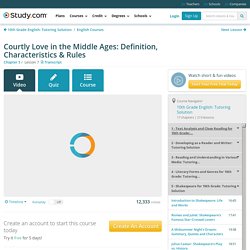
Learn the definition of courtly love, its connection with chivalry, the rules of courtly love, and discover examples of works that feature courtly love from the middle ages. Explore our library of over 10,000 lessons. Medieval Literature. Facts and interesting information about Medieval Life,specifically, Medieval Literature Medieval Literature - The Dark Ages and the BardsEnglish Medieval literature had, so far as we know, no existence until Christian times of the Dark Ages when Latin was the language of English literature.
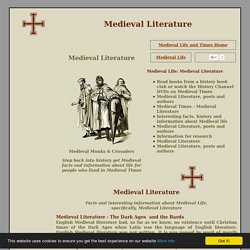
English Medieval literature was not written. What Is Medieval Poetry? (with pictures) Medieval Poems. Poems during the medieval era were religious in nature and written by clerics.
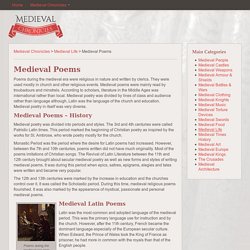
They were used mostly in church and other religious events. Medieval poems were mainly read by troubadours and minstrels. According to scholars, literature in the Middle Ages was international rather than local. Medieval Poetry. Medieval Poetry Romantic stories of courtly love were spread throughout medieval Europe by troubadours and minstrels.
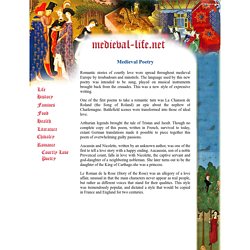
The language used by this new poetry was intended to be sung, played on musical instruments brought back from the crusades. This was a new style of expressive writing. One of the first poems to take a romantic turn was La Chanson de Roland (the Song of Roland) an epic about the nephew of Charlemagne. Medieval literature. Literary works of the Middle Ages Statuta Mutine Reformata, 1420–1485; parchment codex bound in wood and leather with brass plaques worked the corners and in the center, with clasps.

Medieval literature is a broad subject, encompassing essentially all written works available in Europe and beyond during the Middle Ages (that is, the one thousand years from the fall of the Western Roman Empire ca. Medieval Literature. Charlemagne - Facts & Summary. According to Einhard, Charlemagne was in good health until the final four years of his life, when he often suffered from fevers and acquired a limp.

However, as the biographer notes, “Even at this time…he followed his own counsel rather than the advice of the doctors, whom he very nearly hated, because they advised him to give up roasted meat, which he loved, and to restrict himself to boiled meat instead.” In 813, Charlemagne crowned his son Louis the Pious (778-840), king of Aquitaine, as co-emperor. Louis became sole emperor when Charlemagne died in January 814, ending his reign of more than four decades. At the time of his death, his empire encompassed much of Western Europe. Medieval Religion.
Medieval ReligionIn Europe during the Medieval times the only recognised religion was Christianity, in the form of the Catholic religion.
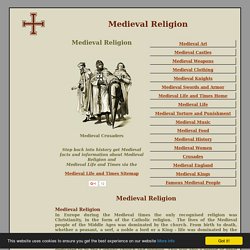
The lives of the Medieval people of the Middle Ages was dominated by the church. From birth to death, whether a peasant, a serf, a noble a lord or a King - life was dominated by the church and Medieval religion. History of Europe - The Middle Ages. Historical era. Alternative titles: le moyen âge; media tempora; medium aevium Middle Ages, Britannica Classic: The Medieval MindEncyclopædia Britannica, Inc.the period in European history from the collapse of Roman civilization in the 5th century ce to the period of the Renaissance (variously interpreted as beginning in the 13th, 14th, or 15th century, depending on the region of Europe and on other factors).
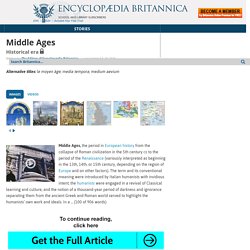
The term and its conventional meaning were introduced by Italian humanists with invidious intent; the humanists were engaged in a revival of Classical learning and culture, and the notion of a thousand-year period of darkness and ignorance separating them from the ancient Greek and Roman world served to highlight the humanists’ own work and ideals. In a ... (100 of 906 words) Middle Ages. Period of European history from the 5th to the 15th century In the history of Europe, the Middle Ages (or medieval period) lasted from the 5th to the 15th century.
It began with the fall of the Western Roman Empire and merged into the Renaissance and the Age of Discovery. The Middle Ages is the middle period of the three traditional divisions of Western history: classical antiquity, the medieval period, and the modern period. The medieval period is itself subdivided into the Early, High, and Late Middle Ages. Population decline, counterurbanisation, collapse of centralized authority, invasions, and mass migrations of tribes, which had begun in Late Antiquity, continued in the Early Middle Ages.